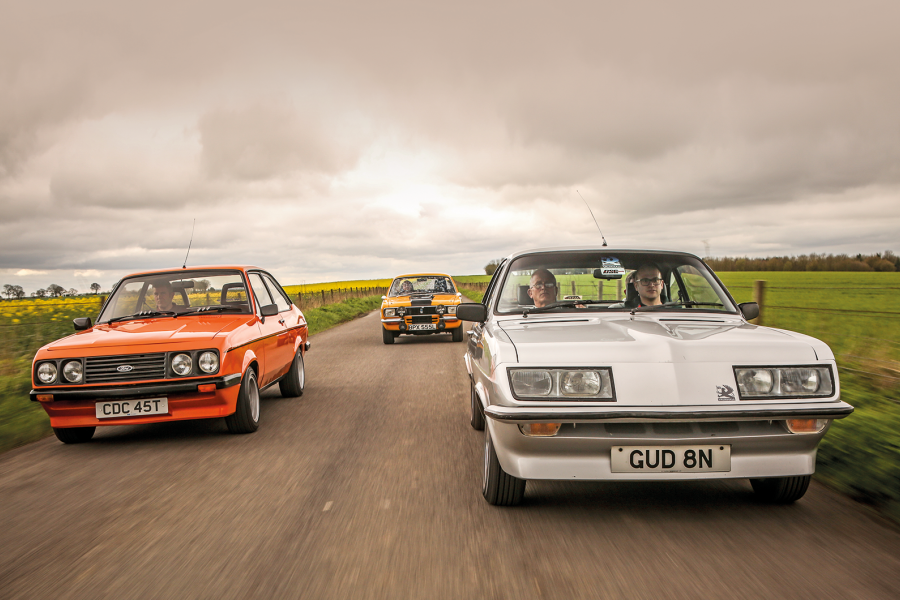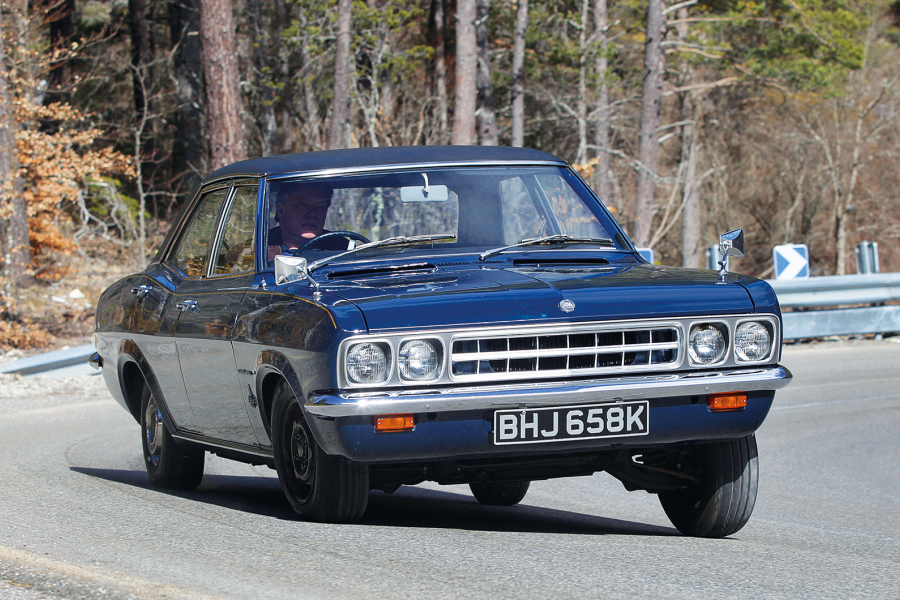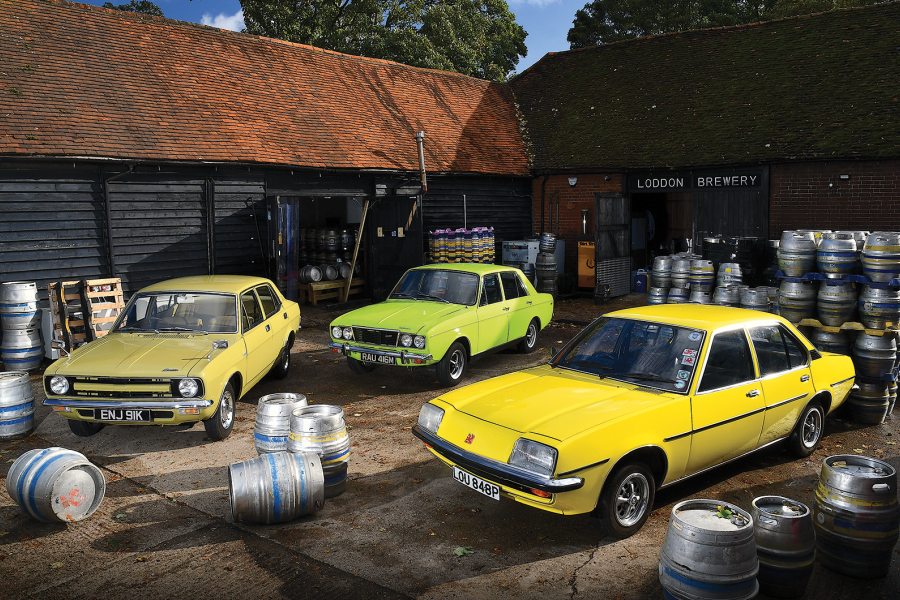Dealers could rightly claim that there was no equivalent 2.3-litre rival from the Ford Escort or Cortina, Hillman Avenger, Morris Marina and even the Triumph Dolomite ranges.
Motor concluded that the 2300SL was: ‘An outstanding car in many ways, but in a few mainly minor ways it is poor.’
In other words, the Viva HC had the potential for further development and improvement, yet in 1973 General Motors decided to cancel the Cortina-sized HD programme.
Instead, Vauxhall would develop its own version of Opel’s forthcoming Ascona B, to be sold as the Cavalier.
This is thought to be the sole-surviving Vauxhall Firenza 1300SL
That year the HC received a facelift, with Vauxhall rebadging the 1.8-litre and 2.3-litre HC saloon and estate as the Magnum.
Terry Howard discovered his Viva in a farmer’s barn in Rainham, Kent, hence its nickname ‘Barney’.
“Magazine advertisements in the 1970s said the 2300SL was a joy to drive,” says Terry, “and ‘wolf in sheep’s clothing’ best sums up my experience of the 2.3-litre HC.
“In terms of performance it is on a par with a Ford Escort RS 2000, and it leaves them standing in the mid-range because of the torque the engine produces.”
The Vauxhall Firenza 1300SL’s 1256cc engine produces 66bhp
“This is thanks to the slant-four’s oversquare pistons: wider bores mean less piston stroke,” he explains.
“Whenever I talk to someone at a car show, the classic opening line is always ‘my family had a Viva’.”
The final member of our quartet is the Firenza, which used the name of the ill-fated Canadian export model.
It took its bow on 26 May 1971 as ‘the kind of car that makes you impatient to be on your way’.
This Vauxhall Viva HC 2300SL sports the Plumaflex front seats
Cost constraints meant that it employed the same panelwork as a two-door HC saloon below the waistline, which resulted in complaints from dealerships holding out for a Ford Capri rival, who further grumbled that Opel showrooms could display the stylish Manta A.
The original engine line-up consisted of the Viva’s 1159cc, 1599cc and 1975cc ‘fours’, but for 1972 they were replaced by 1256cc, 1759cc and 2279cc units.
After late ’73, following the introduction of the Magnum, Vauxhall used the Firenza name solely on the High Performance ‘Droopsnoot’ version.
The Vauxhall Viva HC 2300SL’s busy dials include a 120mph speedo
BWK 442K is thought to be the sole-surviving 1300SL and has been owned by the Yearby family since new.
Today, the Flamenco Red Firenza is in the custodianship of Christopher, the original owner’s nephew, and his son, Mark.
Despite the shared origins, the Firenza’s coupé roofline is striking – the guest at the Vauxhall presentation who dismissively referred to it as a “bubble-top Viva” was clearly just being negative.
The Yearbys’ HC is a stark reminder of Vauxhall’s challenge in the early 1970s – namely, to convince customers that it was worth spending £65 more than the price of a Viva 1300SL, and that it was more groovy than a Capri 1300.
The Vauxhall Firenza 1300SL’s cabin has a low-key black finish
The Firenza SL’s quad headlights added sales appeal, and spending £35 on the optional RoStyle rims – ‘the extra-distinctive wheel that turns heads’ – helped to distract from that mundane strip speedometer.
“Being a 1256cc version, it’s never going to melt Tarmac with its speed and acceleration,” admits Mark, “but it does a nice job of A- and B-roads; it seems to suit them perfectly.
“On a motorway it can feel as if the engine is revving very high at 70mph, but it’s most comfortable at 55-60mph.
“Cornering-wise it’s quite soft, but it can’t really be compared with the HP Firenza or the other bigger-engined cars.”
The strip speedo is at odds with the Firenza’s sporty styling
“It’s certainly comfortable to drive, though: remember, this was my uncle’s daily driver – and it’s now mine, come to that,” he continues.
“Most people have no idea what it is, and even when we tell them it’s a Firenza they still don’t recognise it.
“However, the older generation does see the Viva link.”
In 1975, the introduction of the Chevette marked the beginning of the end for the Viva, although sales of the HC soldiered on until July 1979.
‘The Vauxhall Chevette marked the beginning of the end for the Viva, although HC sales continued until July 1979’
By that stage, however, Vauxhall had lost its design independence and, in a development the HA foretold, the brand would thereon be associated with anglicised Opels.
Of our family gathering, the two HCs convey more ultra-1970s appeal than dinner à deux at the Angus Steakhouse, while the HA SL90 would have looked perfectly at home on the driveway in a Scales of Justice B-film suburban mystery.
But my choice has to be the racey HB Brabham De Luxe, both for its sheer exclusivity and because it looks so appealing in Pageant Red – and who could resist the lure of those fabulous zoom stripes?
Images: Max Edleston
Thanks to Luton Hoo Hotel (01582 734437); The Vauxhall Viva Owners’ Club
Factfiles
Vauxhall Viva HA SL90
- Sold/number built 1965-’66/309,538
- Construction steel unitary
- Engine all-iron, ohv 1057cc ‘four’, single Solex carburettor
- Max power 54bhp @ 5600rpm
- Max torque 60lb ft @ 3200rpm
- Transmission four-speed manual, RWD
- Suspension: front independent, by wishbones, transverse leaf spring rear live axle, torque tube, semi-elliptic leaf springs; telescopic dampers f/r
- Steering rack and pinion
- Brakes discs front, drums rear, with servo
- Length 12ft 11in (3937mm)
- Width 4ft 11½in (1511mm)
- Height 4ft 5in (1346mm)
- Wheelbase 7ft 3in (2324mm)
- Weight 1750lb (794kg)
- Mpg 27.7
- 0-60mph 18.1 secs
- Top speed 81mph
- Price new £648 5d
- Price now £8000*
Vauxhall Viva HB Brabham
- Sold/number built 1967-’68/566,391
- Construction steel unitary
- Engine all-iron, ohv 1159cc ‘four’, twin Zenith-Stromberg carburettors
- Max power 68bhp @ 5800rpm
- Max torque 66lb ft @ 3800rpm
- Transmission four-speed manual, RWD
- Suspension: front independent, by wishbones rear live axle, diagonal links, radius arms; coil springs, telescopic dampers f/r
- Steering rack and pinion
- Brakes discs front, drums rear, with servo
- Length 13ft 5½in (4102mm)
- Width 5ft 13in (1600mm)
- Height 4ft 5in (1346mm)
- Wheelbase 7ft 11½in (2426mm)
- Weight 1734lb (788kg)
- Mpg 27
- 0-60mph 15.1 secs
- Top speed 93mph
- Price new £728
- Price now £10,000+*
Vauxhall Viva HC 2300SL
- Sold/number built 1970-’79/640,863
- Construction steel unitary
- Engine all-iron, sohc 2279cc slant-four, twin Zenith-Stromberg carburettors
- Max power 110bhp @ 5200rpm
- Max torque 140lb ft @ 3000rpm
- Transmission four-speed manual, RWD
- Suspension: front independent, by wishbones, anti-roll bar rear live axle, longitudinal lower arms, diagonal links; coil springs, telescopic dampers f/r
- Steering rack and pinion
- Brakes discs front, drums rear, with servo
- Length 13ft 6in (4114mm)
- Width 5ft 4½in (1643mm)
- Height 4ft 6½in (1384mm)
- Wheelbase 8ft 1in (2464mm)
- Weight 2251lb (1021kg)
- Mpg 18.6
- 0-60mph 12.4 secs
- Top speed 95mph
- Price new £1274
- Price now £6000*
Vauxhall Firenza 1300SL
- Sold/number built 1971-’73/18,352
- Construction steel unitary
- Engine all-iron, ohv 1256cc ‘four’, single Zenith carburettor
- Max power 66bhp @ 5400rpm
- Max torque 71lb ft @ 3600rpm
- Transmission four-speed manual, RWD
- Suspension: front independent, by wishbones, anti-roll bar rear live axle, longitudinal lower arms, diagonal links; coil springs, telescopic dampers f/r
- Steering rack and pinion
- Brakes discs front, drums rear, with servo
- Length 13ft 6in (4114mm)
- Width 5ft 4½in (1643mm)
- Height 4ft 6in (1372mm)
- Wheelbase 8ft 1in (2464mm)
- Weight 1865lb (846kg)
- Mpg 24
- 0-60mph 17.6 secs
- Top speed 83mph
- Price new £1051.88
- Price now £8000*
*Prices correct at date of original publication
Enjoy more of the world’s best classic car content every month when you subscribe to C&SC – get our latest deals here
READ MORE
21 luxury Vauxhalls
Budget sporting saloons: Triumph Vitesse vs Vauxhall Viva GT
Buyer’s guide: Vauxhall Viva
Andrew Roberts
Andrew is a long-time contributor to Classic & Sports Car




























